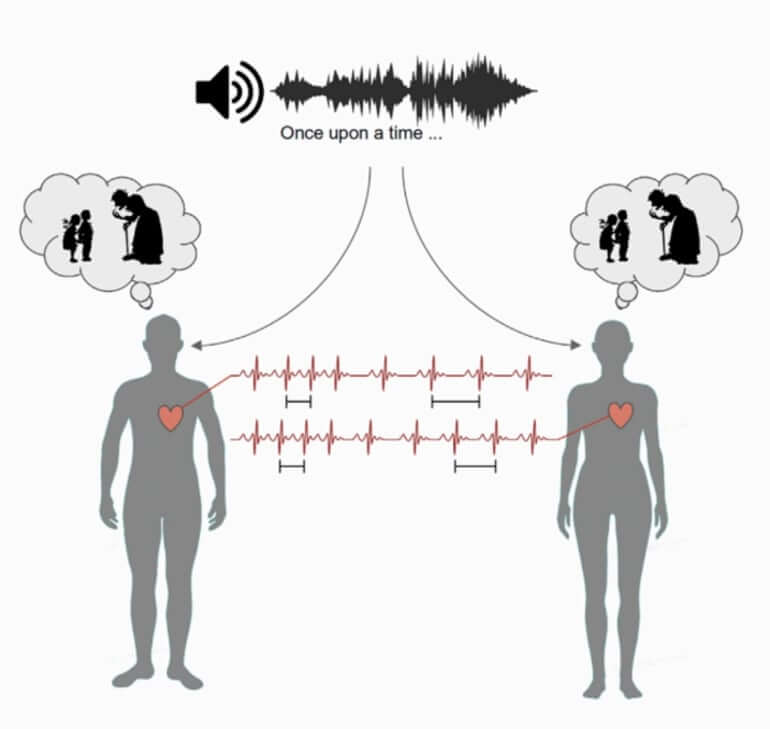Heart rate synchronization occurs, even when subjects are listening to a story alone, when they are attentive to certain points in the story
14.9.21 Processing: Gilat Simon Source: Cell Report magazine

Synchronization of bodily functions, such as heart rate or breathing rate, often occurs between people, without them being aware of it, when they experience a certain experience together, such as a live performance or a personal conversation. According to a new study, subjects' heart rates are synchronized even if they are just listening to a story by themselves, as long as they are paying attention to the story.
"There is extensive literature demonstrating physiological synchronization between humans. But the premise is that somehow you are interacting and physically present in the same place" says one of the authors of the article, Prof. Lucas Parra, from City College in New York. "What we found (in the current study) is that the phenomenon is much broader, that it is enough to follow a story and processing the stimulus will cause the same fluctuations in the heart rate of different subjects. It is the cognitive function that increases or slows down your heart rate"
"What is important is that the listener is attentive to the actions in the story." Adds Jacob Sit, one of the authors of the article, "It's not about feelings, but about being busy and attentive, as well as thinking about what will happen next. Your heart responds to these brain signals.”
The researchers conducted a series of four experiments to investigate the role of awareness and attention in regulating heart rate among subjects. In the first experiment, healthy volunteers listened to Jules Verne's audiobook, 20,000 Miles Under Water.
As they listened, their heart rate changed based on what happened in the story, as measured by an electrocardiogram (EKG). The researchers found that most subjects showed an increase and decrease in their heart rate at the same points in the narrative.
In the second experiment, volunteers watched short training videos. Because the videos were educational, without many emotional ones, this experiment confirmed that emotional attachment to the story does not play a role (does not affect heart rate changes). The first time they watched the videos, the subjects' heart rate showed the same fluctuation.
Then, the subjects watched the videos a second time, while performing a mental countdown task. This time, the lack of attention caused a decrease in heart rate synchronization between the subjects, thus confirming the assumption that attention is the important factor in synchronization.
In the third experiment, the subjects listened to short children's stories, some while attentive and others while being interrupted, and then all were asked to recall facts from the stories. The researchers found that the fluctuations seen in the heart rate of the subjects predicted the degree of success in correct answers to the story - greater synchronization predicted higher results in the test. These results indicate that heart rate changes are a signal for conscious processing of the story.
When the researchers tested changes in breathing rate, no similar synchronization was found between the subjects. This finding is surprising since it is known that breathing affects the heart rate.
The fourth experiment was the same as the first, but included both healthy volunteers and patients with disorders of awareness (consciousness) - such as a coma or a "plant" state. All subjects were played a children's story (in an audio book). As expected, the patients showed a lower rate of cardiac synchronization compared to the healthy control group. When the patients were examined after six months, some of those who showed higher synchronization regained partial recognition.
"This research is still preliminary, but imagine its application as a simple test that can measure brain function" says Sitt "not much equipment is required. It can even be performed in an ambulance on the way to the hospital." He comments that more validation is needed with larger numbers of patients as well as comparisons to conventional tests of brain function such as EEG and fMRI. The research group continues to examine these areas as well.
Parra says that such research is also important for understanding mindfulness and the mind-body connection. "Neuroscience is a field that has opened up in terms of thinking about the brain as an actual anatomical part of the physical body" or says "this research is a step in the direction of looking at the mind-body connection in a broader way, in terms of how the brain affects the body".
More of the topic in Hayadan:
